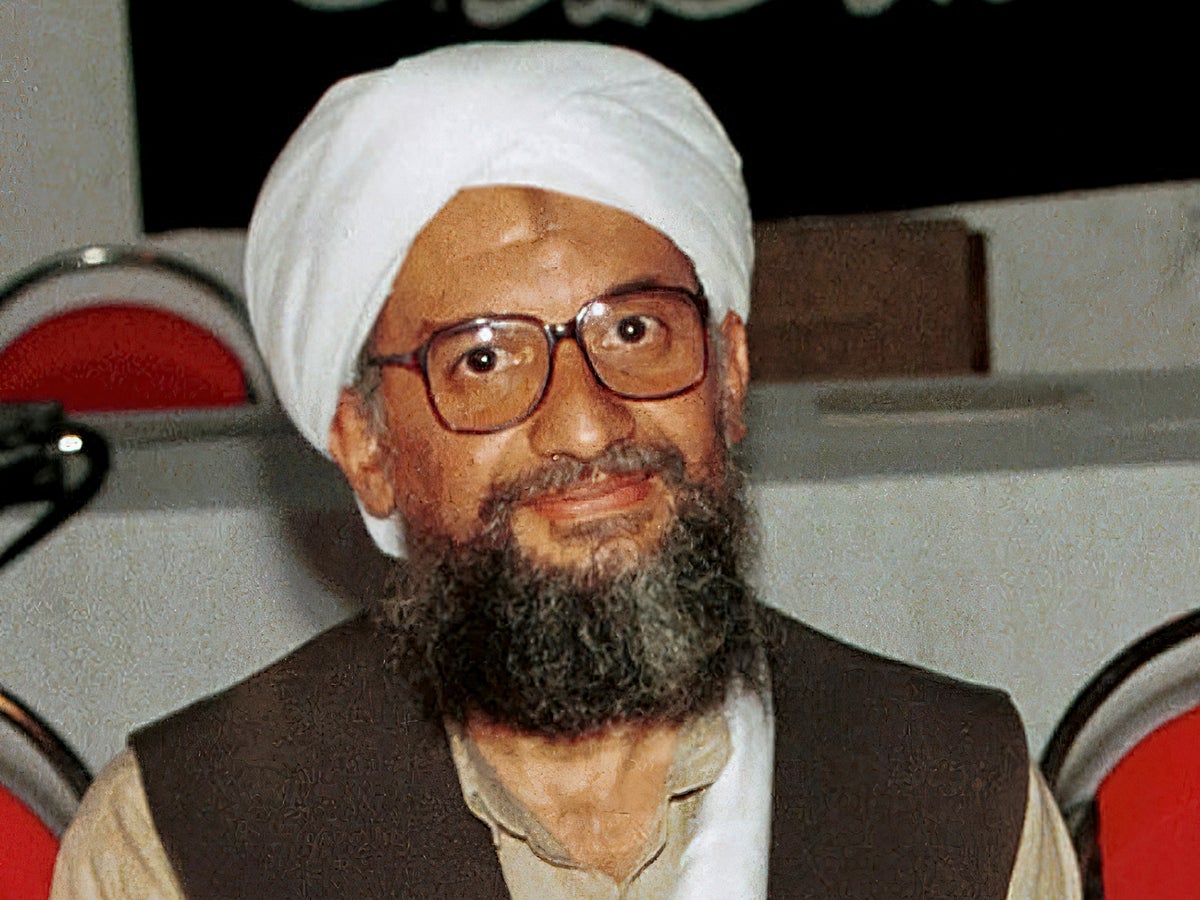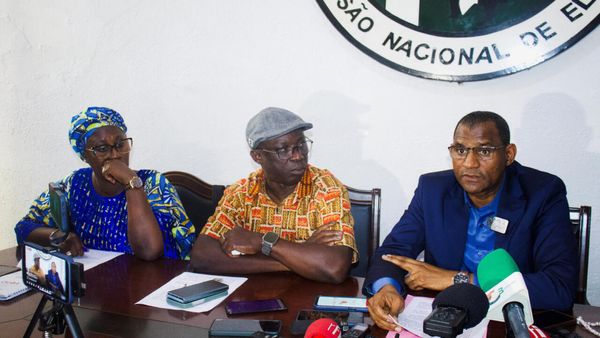
Americans knew him as al-Qaeda’s No 2 leader, the bespectacled, bushy-bearded deputy to Osama Bin Laden. But in reality, it was Ayman al-Zawahiri’s brains and blood-drenched hands that guided the world’s most notorious terrorist movement.
Al-Zawahiri, 71, was killed in a CIA drone strike in Kabul over the weekend, according to officials familiar with the matter who spoke on the condition of anonymity to discuss sensitive intelligence.
Al-Zawahiri had led his own militant group and pioneered a brand of terrorism that prized spectacular attacks and the indiscriminate slaughter of civilians. When he formally merged his group with al-Qaeda in the 1990s, he brought along those tactics as well as an expanded vision for attacking the west.
It was al-Zawahiri who postulated that defeating the “far enemy” – the US – was an essential precursor to taking on al-Qaeda’s “near enemy”, the pro-western Arab regimes that stood in the way of the group’s dream of uniting all Muslims under a global caliphate.
“To kill Americans and their allies – civilian and military – is an individual duty for every Muslim who can do it in every country in which it is possible to do it,” al-Zawahiri wrote in a 1998 manifesto. Three years later, he would put words into action by helping to plan the 9/11 attacks.
Though lacking Bin Laden’s personal charisma, al-Zawahiri became the intellectual force behind many of al-Qaeda’s grandest ambitions, including its apparently unsuccessful efforts to acquire nuclear and biological weapons. And, after the group’s forced retreat from its base in Afghanistan in early 2002, it was largely al-Zawahiri who led al-Qaeda’s resurgence in the lawless tribal region across the border in Pakistan, according to longtime observers of the terrorist group.
In his later years, al-Zawahiri presided over al-Qaeda at a time of decline, with most of the group’s founding figures dead or in hiding and the organisation’s leadership role challenged by aggressive upstarts such as the Islamic State.
He remained the terrorist group’s figurehead but failed to prevent the splintering of the Islamist movement in Syria and other conflict zones after 2011. Rumoured to be in ill health, he became known for his long disappearances from public view, interrupted occasionally by the release of essays, books and videotaped sermons that showcased a characteristically dry, pedantic style that seemed ill-suited for the age of social media.
Al-Zawahiri’s path to becoming one of the world’s most recognised terrorists had an unlikely beginning in an upper-middle-class, religiously diverse Cairo suburb that was home to many of Egypt’s most accomplished families.
Al-Zawahiri’s father, Mohammed Rabie al-Zawahiri, was a professor of pharmacology, and his maternal grandfather was a president of Cairo University. At the time of al-Zawahiri’s birth in 1951, his hometown of Maadi had a large Jewish population and boasted more churches than mosques.
An earnest, academically gifted youth, he was influenced early in life by one of his uncles, Mahfouz Azzam, an impassioned critic of Egypt’s secularist government, and by the writings of Sayyid Qutb, an Egyptian author and intellectual who became one of the founders of 20th-century Islamist extremism.
According to an account by Lawrence Wright in his Pulitzer Prize-winning book The Looming Tower, it was the execution of Qutb by Egypt’s government in 1966 that inspired al-Zawahiri, then 15, to organise a group of young friends into an underground cell devoted to the overthrow of Egypt’s government and the establishment of an Islamic theocracy. Al-Zawahri’s small band of followers eventually grew into an organisation known as Jamaat al-Jihad, or the Jihad Group.
Even as his political views hardened, al-Zawahiri was pursuing a career in the healing arts, earning a degree in medicine from Cairo University and serving briefly as an army surgeon. He eventually opened a practice in a duplex owned by his parents, and he occasionally tended patients at a Cairo clinic sponsored by the Muslim Brotherhood, a Sunni Islamist political opposition group. He married Azza Nowair, the daughter of a wealthy, politically connected Egyptian family, and the couple eventually would have a son and five daughters.
While working at the Muslim Brotherhood clinic, al-Zawahiri was invited to make the first of numerous visits to refugee camps along the Afghanistan-Pakistan border. There, he patched up the wounds of mujahideen who were fighting the Soviets in Afghanistan and crossed paths with a charismatic young Saudi, Bin Laden.
At the time, however, al-Zawahiri was preoccupied with managing his own revolutionary movement. His Jihad Group initiated a series of plots in the early 1980s to assassinate Egyptian leaders and played a role in the slaying of Egyptian President Anwar Sadat in 1981.
The massive government crackdown that followed landed al-Zawahiri in prison, along with hundreds of his followers. Al-Zawahiri was released after serving a three-year sentence, but he would later claim in a memoir that he was tortured during his imprisonment, an experience that he said left him more determined to destroy Egypt’s government through force.
During his nomadic years after prison, al-Zawahiri traveled frequently to South Asia and increasingly found common cause with the mujahideen and with Bin Laden himself, who came to rely on the Egyptian as his personal physician. Al-Zawahiri’s steadiness in rendering aid in the face of Soviet bombardment in Afghanistan cemented the doctor’s reputation among the mujahideen, as well as a lifelong friendship with Bin Laden.
Al-Zawahiri made at least one visit to the US in the 1990s, a brief tour of California mosques under an assumed name to raise money for Muslim charities providing support for Afghan refugees. At the same time, he continued to press his Egyptian followers toward larger and more spectacular attacks at home, believing that such shockingly brutal tactics would command media attention and drown out more-moderate voices that advocated negotiation and compromise.
While living in Afghanistan in 1997, al-Zawahiri helped plan a savage attack on foreign tourists at Egypt’s famous Luxor ruins, a 45-minute killing that claimed the lives of 62 people, including Japanese tourists, a five-year-old British girl and four Egyptian tour guides.
Ordinary Egyptians were repelled by the slaughter, and support for al-Zawahiri and his Jihad Group evaporated. Soon afterwards, al-Zawahiri told followers that operations in Egypt were no longer possible and that the battle was shifting to Israel and its chief ally, the US. The Jihad Group officially merged with Bin Laden’s larger and better-financed al-Qaeda, or “The Base”.
Al-Zawahiri was a senior adviser to Bin Laden at the time of al-Qaeda’s first high-profile terrorist attacks, the 1998 bombings of US embassies in Kenya and Tanzania. Three years later, working from al-Qaeda’s base in Afghanistan, he helped oversee the planning of what would become one of history’s most audacious terrorist attacks: 9/11.
As the September 11 hijackers were dispatched to begin training, al-Zawahiri was put in charge of planning follow-on waves of terrorist attacks intended to further weaken America’s economy and resolve. He launched an ambitious biological weapons programme, establishing a laboratory in Afghanistan and dispatching disciples to search for sympathetic scientists as well as lethal strains of anthrax bacteria.
Intelligence officials believe that al-Zawahiri’s efforts might well have succeeded, had he not run out of time. Within weeks of the collapse of the World Trade Center, a US-backed military campaign drove al-Qaeda’s Taliban allies out of power in Afghanistan and forced al-Zawahiri to abandon his bioweapons lab.
US aircraft targeted al-Qaeda leaders’ offices and homes, including the compound where al-Zawahiri lived. His wife was trapped in rubble after the roof collapsed, but she reportedly refused to be rescued out of fear that men would see her without her veil. She was later found dead of hypothermia.
Al-Zawahiri fled with Bin Laden to Pakistan’s tribal region, where both men – now with bounties of $25m (£20.7m) on their heads – went into hiding to avoid capture. Though there were no confirmed sightings of either man in the following decade, the CIA launched at least two missile strikes inside Pakistan, in 2006 and 2008, that reportedly targeted buildings recently occupied by him.
Despite the intense manhunt, al-Zawahiri continued to make regular appearances in videos posted online. US officials believe he also continued to direct numerous terrorist operations, including the 2007 siege of the Red Mosque in Islamabad, Pakistan, that resulted in more than 100 deaths.
Though he occasionally sparred with younger extremists over tactics – he argued that mass killings of Muslims in Iraq had undermined support for al-Qaeda – he never publicly wavered in his hatred for the West or his support for violent jihad.
The death of Bin Laden in 2011 thrust al-Zawahiri into the No 1 position, a role for which, in hindsight, he may not have been ideally suited. The Egyptian, with his dry, cerebral style, failed to inspire jihadists as powerfully as Bin Laden or younger leaders such as Abu Musab al-Zarqawi, founder of the Iraqi insurgency that would later become the Islamic State.
After the start of the Arab Spring uprisings, al-Zawahiri sought to assert command over the patchwork of locally led Islamist groups fighting for dominance in Syria, Iraq and Libya. His effort would ultimately fail.
The leading al-Qaeda affiliate in Syria, known initially as the al-Nusra Front, eventually chose to distance itself from the parent organisation, refusing to formally accept the al-Qaeda brand. The other major faction, the Islamic State, broke with al-Zawahiri entirely and drew a public denunciation from him.
In the decade that followed, partisans within both groups would duel over strategy, tactics and even basic beliefs, but rarely, if ever, looked to al-Zawahiri for guidance or resolution of their disputes.
Ayman al-Zawahiri, terrorist and head of al-Qaeda, born 19 June 1951, died 31 July 2022
Julie Tate contributed to this report
© The Washington Post







